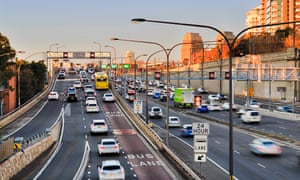Countries also raise concerns about rise in Australia’s transport emissions and the use of Kyoto carry-over credits
The Morrison government has been challenged by the European Union
and by China about whether it can meet its Paris commitments given
rising emissions, and about growing pollution from vehicles, ahead of a
progress meeting about climate commitments in Bonn next week.
Nineteen countries, including Australia, will gather in Bonn on 24 and 25 June for a multilateral assessment of progress made under international climate commitments, and ahead of that session countries have submitted a range of questions about the performance of signatories in meeting their climate targets.
As well as questions about rising emissions, the EU and Canada have also queried the Morrison government’s decision to use carry-over credits from the Kyoto protocol in its latest carbon budget.
The Coalition is counting a 367 megatonne abatement from carry-over credits
(an accounting system that allows countries to count carbon credits
from exceeding their targets under the soon-to-be-obsolete Kyoto
protocol periods against their Paris commitment for 2030) to help meet
Australia’s 2030 target.Nineteen countries, including Australia, will gather in Bonn on 24 and 25 June for a multilateral assessment of progress made under international climate commitments, and ahead of that session countries have submitted a range of questions about the performance of signatories in meeting their climate targets.
As well as questions about rising emissions, the EU and Canada have also queried the Morrison government’s decision to use carry-over credits from the Kyoto protocol in its latest carbon budget.
The EU in its questions to Australia points out that net emissions will grow during the period 2013 to 2020 and notes “Australia is also increasing coalmining, in particular for export”.
It has asked whether Australia considers its emissions profile, which has seen pollution rise since the repeal of the carbon price, to be “on a structural path of decrease in line with its commitments”. It has also flagged fossil fuel exports and asked whether they are sustainable “in the context of Paris agreement”.
Morrison government officials have addressed the implicit criticism by arguing in a submitted answer that “Australia’s national emissions peaked in 2007” and pointing to a fall in emissions per capita.
It says even without its climate policies, unveiled just before the recent federal election, including the reboot of the Abbott-era emissions reduction fund (ERF), “the decoupling of economic growth from greenhouse gas emissions has been progressing steadily since 1990”.
The government says the mix in electricity generation has changed between 2013 and 2020, and the Renewable Energy Target (RET) will see renewable energy grow to about 23.5% of Australia’s energy mix by 2020.
Australian officials do not, in the answer to the EU, mention the RET winds down from 2020, or that a sectoral target to drive emissions reduction in the electricity sector, proposed by Malcolm Turnbull in the national energy guarantee, was scrapped after he was replaced as prime minister by Scott Morrison.
The EU has also challenged Australia on its 2030 Paris target, pointing out “on the basis of reported projections with existing policies and measures it is not on track to meet this commitment”.
The EU asked Australia whether it would need further policies to meet the Paris commitment, given the current trends. Australian government officials point to the policies outlined before the recent election, including the funding boost for the ERF.
But in defending the status quo, the government has also restated a commitment to “review and refine” domestic policies aligned with the five-yearly review process under the Paris agreement. “This approach will provide for integrated consideration of domestic policy and international targets, and provide guidance for industry about future policy review processes,” officials said.
China, in a question to Australia, notes there will be a significant increase in transportation greenhouse gas emissions, and asks what measures Australia plans to take to reduce transport pollution in the future.
While the Morrison government pilloried Labor in the recent election campaign for proposing a vehicle emissions standard and targets for the uptake of electric vehicles, characterising Labor’s plans as a “war on the weekend”, government officials have told China the Coalition “is supporting low and zero emissions transport options in a number of ways”.
It says it is “developing” a national electric vehicle strategy – a strategy the government has not yet unveiled – which it says will build on support being rolled out through the Australian Renewable Energy Agency and the Clean Energy Finance Corporation.
It also points to the government’s Green Vehicle Guide website, and mandatory fuel consumption and carbon dioxide emission labels, that “help consumers identify and choose more fuel efficient vehicles” as well as “action to bring our fuel quality in line with international standards”.
The government says the safeguard mechanism “puts regulated limits on the emissions of large transport facilities that emit more than 100,000 tonnes C02-equivalent each year (mostly rail freight, domestic aviation and shipping)” and says the ERF “incentivises businesses, households and landowners to proactively reduce their emissions [and] provides incentives to reduce the emissions intensity of land and sea transport activity”.
It also points to the national hydrogen strategy, which is being led by Australia’s chief scientist, Alan Finkel, which is due to be delivered by the end of 2019.

No comments:
Post a Comment